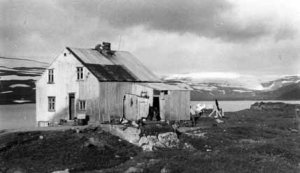
|
|||||||||
|

25. Höfdaströnd
At the highest and outermost point of the field at Höfdaströnd are substantial ruins called Beinrófa. It is believed that the old Höfdastrandarbćr farm had been situated there, but had been abandoned when an epidemic hit. No excavation has taken place there out of fear of disease; it's belived that under thd ground can be found all the farm materials of that time. The Tídagötur trail lies from the ridge above Höfdaströnd to Stadarheidi. In the final years of the community at Grunnavíkurhreppur there were three farms at Höfdaströnd, called Nedribćr, Hćrribćr and Steinhólar. Hćrribćr was highest up and inmost of the farms. At Nedribćr, by the sea, lived midwife Ragnheidur Jónsdóttir and Gudbjartur Kristjánsson. Their house has now been renovated. Below the farm is the landing area called Vör. The final inhabitants of Nedribćr were Grímur Finnbógason and Gudrún Finnbogadóttir Steinhólar was furthest out of the farms, it was first settled in the 20th century. Above the Höfdaströnd coast towers Hrafnabjörg. It's an easy walk to the top, and there is a good view from there. In the story collection Vestfirzkar thjódsögur, it says that the ghost Mópeys made its presence felt around Höfdaströnd. Mópeys is described as a young boy in a reddish sweater with a skin shoe on one foot and a boot on the other. He had died of exposure and his spirit had risen, troubling people on certain farms on Hornstrandir and Jökulfirdir with its spells and pranks. Back |
||||||||
 Eleven people lived at Höfdaströnd in 1703, among them the lawman Ólafur Árnason. In 1801 there were nine, at two farms. In Jardabók it says that there had been a prayer house at Höfdaströnd in the old days, before the time of anyone alive at the beginning of the 1800s.
Eleven people lived at Höfdaströnd in 1703, among them the lawman Ólafur Árnason. In 1801 there were nine, at two farms. In Jardabók it says that there had been a prayer house at Höfdaströnd in the old days, before the time of anyone alive at the beginning of the 1800s.